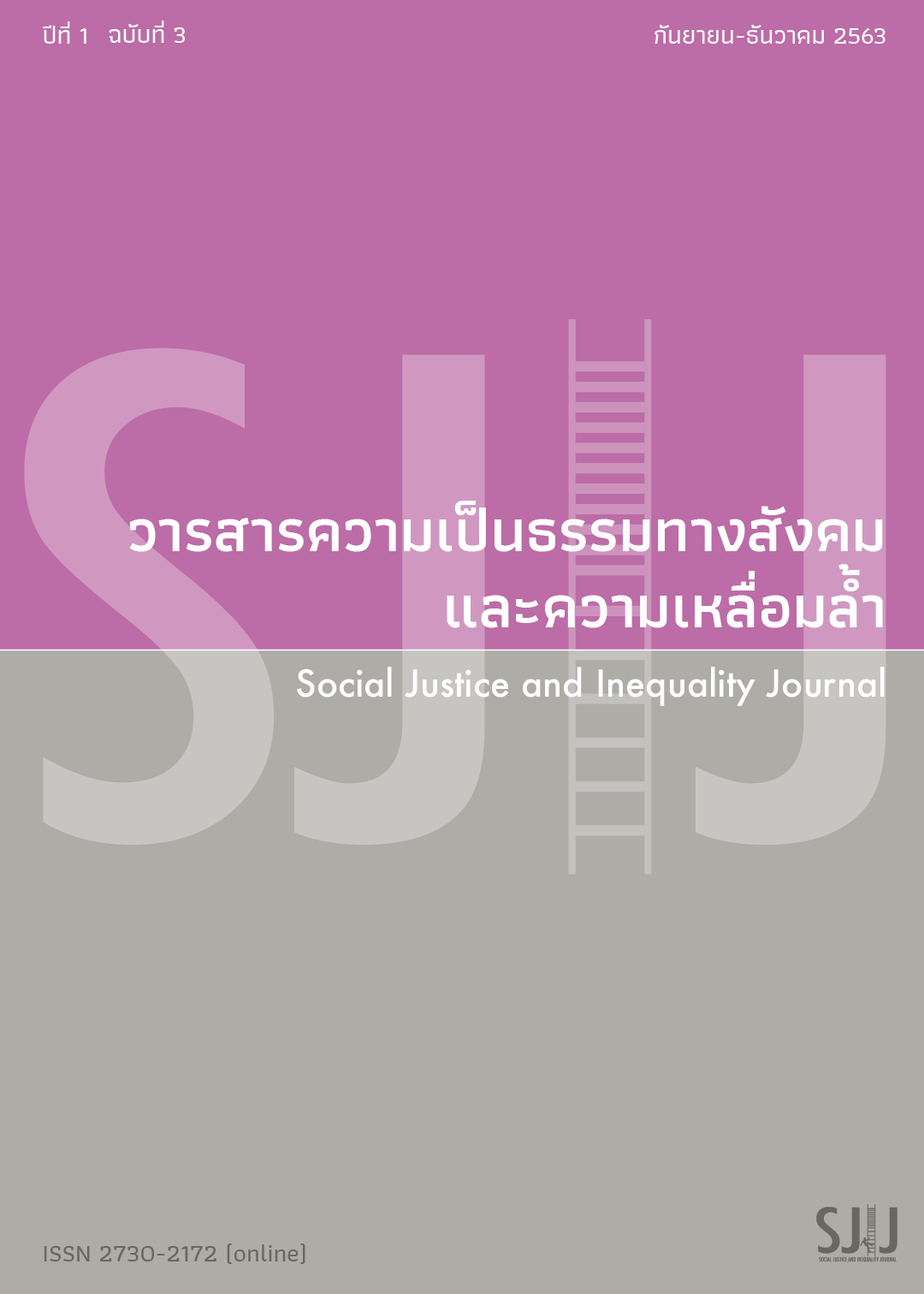Manipulation of academic publication: gaming the system in publish-or-perish culture
การฉ้อฉลในการเผยแพร่งานทางวิชาการ: กลโกงภายใต้วัฒนธรรม “เผยแพร่หรือแพ้พ่าย”
Keywords:
Academic Fraud, Publication Ethics, Citation Manipulation, Paper Mills, Predatory PublisherAbstract
Pressure to publish in academic circles has increased in the recent years. Universities and research institutes use different measures to motivate publications, including monetary publication rewards or refusing to extend work contracts if publication requirementsare not met. Furthermore, research funding and academic positions are awarded with strong emphasis on quantitative publication metrics such as number of papers, citation number and journal ranking. A combination of these factors could lead to serious publication misconduct. This article aims to give an overview of publication fraud and systematic publication manipulation, including their characteristic patterns so that readers and authors of academic paperscan recognize such manipulation themselves. This article also aims to raise awareness among universities, funding agencies and research policy makers to rethink their use of quantitative criterion for academic evaluation and helpmitigate the downsides of publish-or-perish culture.
References
Byrne, J. A., & Christopher, J. (2020). Digital magic, or the dark arts of the 21st century—how can journals and peer reviewers detect manuscripts and publications from paper mills? FEBS Letters, 594(4): 583–589. https://doi.org/10.1002/1873-3468.13747.
Cobey, K. D., De Costa E Silva, M., Mazzarello, S., Stober, C., Hutton, B., Moher, D., & Clemons, M. (2017, July 1). Is this conference for real? Navigating presumed predatory conference invitations.Journal of Oncology Practice, Vol. 13, pp: 410–413. https://doi.org/10.1200/JOP.2017.021469.
Committee on Publication Ethics. (2019). Plagiarism and inclusivity highlighted in new study into the arts, humanities and social sciences. https://doi.org/https://doi.org/10.24318/ cope.2019.4.1.
Committee on Publication Ethics (COPE). (2019). Predatory Publishing: Discussion document: https://doi.org/10.24318/cope.2019.3.6.
Davis, P. (2012). The Emergence of a Citation Cartel - The Scholarly Kitchen. Retrieved August 20, 2020, from https://scholarlykitchen.sspnet.org/2012/04/10/emergence-of-a-citation-cartel/.
Fanelli, D. (2009). How many scientists fabricate and falsify research? A systematic review and meta-analysis of survey data. PLoS ONE, 4(5).
https://doi.org/10.1371/journal.pone.0005738.
Fanelli, D., Costas, R., Fang, F. C., Casadevall, A., & Bik, E. M. (2019). Testing Hypotheses on Risk Factors for Scientific Misconduct via Matched-Control Analysis of Papers Containing Problematic Image Duplications. Science and Engineering Ethics, 25(3): 771–789. https://doi.org/10.1007/s11948-018-0023-7.
Fanelli, D., Costas, R., & Larivière, V. (2015). Misconduct policies, academic culture and career stage, not gender or pressures to publish, affect scientific integrity. PLoS ONE, 10(6). https://doi.org/10.1371/
journal.pone.0127556.
Federal policies | ORI - The Office of Research Integrity. (n.d.). Retrieved August 17, 2020, from https://ori.hhs.gov/content/chapter-2-research-misconduct-federal-policies.
Fire, M., & Guestrin, C. (2019). Over-optimization of academic publishing metrics: Observing Goodhart’s Law in action. GigaScience, 8(6): 1–20. https://doi.org/10.1093/gigascience/giz053.
Focus, N. (2013). China’ s Publication Bazaar. Science, 342(November), 1035–1039.
Grimes, D. R., Bauch, C. T., & Ioannidis, J. P. A. (2018). Modelling science trustworthiness under publish or perish pressure. Royal Society Open Science, 5(1): 171511. https://doi.org/10.1098/rsos.171511.
Hardwicke, T. E., Wallach, J. D., Kidwell, M. C., Bendixen, T., Crüwell, S., & Ioannidis, J. P. A. (2020). An empirical assessment of transparency and reproducibility-related research practices in the social sciences (2014-2017). Royal Society Open Science, 7(2). https://doi.org/10.1098/rsos.190806.
Ioannidis, J. P. A., & Khoury, M. J. (2014). Assessing value in biomedical research the PQRST of appraisal and reward. JAMA - Journal of the American Medical Association, Vol. 312, pp. 483–484. https://doi.org/10.1001/jama.2014.6932.
Ioannidis, J. P. A., & Thombs, B. D. (2019). A user’s guide to inflated and manipulated impact factors. European Journal of Clinical Investigation, 49(9). https://doi.org/10.1111/eci.13151.
Kolata, G. (2017, October 30). Many Academics Are Eager to Publish in Worthless Journals - The New York Times. Retrieved August 20, 2020, from https://www.nytimes.com/2017/10/30/science/predatory-journals-academics.html.
Lao, R. (2018). Thai universities must look beyond ranking - Modern Diplomacy. Retrieved August 17, 2020, from https://moderndiplomacy.eu/2018/02/23/thai-universities-must-look-beyond-ranking/.
Mallapaty, S. (2020, March 1). China bans cash rewards for publishing papers. Nature, Vol. 579, p. 18. https://doi.org/10.1038/d41586-020-00574-8.
Miguel, E., Camerer, C., Casey, K., Cohen, J., Esterling, K. M., Gerber, A., … Van Der Laan, M. (2014, January 3). Promoting transparency in social science research. Science, Vol. 343, pp. 30–31. https://doi.org/10.1126/science.1245317.
Misra, D. P., Ravindran, V., Wakhlu, A., Sharma, A., Agarwal, V., & Negi, V. S. (2017, November 1). Publishing in black and white: the relevance of listing of scientific journals. Rheumatology International, Vol. 37, pp. 1773–1778. https://doi.org/10.1007/s00296-017-3830-2.
Noorbala, A. A., Bagheri Yazdi, S. A., Faghihzadeh, S., Kamali, K., Faghihzadeh, E., Hajebi, A., … Asadi, A. (2017). Trends of mental health status in Iranian population aged 15 and above between 1999 and 2015. Archives of Iranian Medicine, 20(11), S2–S6.
Patwardhan, B. (2019, July 4). Why India is striking back against predatory journals. Nature, Vol. 571, p. 7. https://doi.org/10.1038/d41586-019-02023-7.
Salami publication | COPE: Committee on Publication Ethics. (n.d.). Retrieved August 17, 2020, from https://publicationethics.org/case/salami-publication.
Schneider, L. (2020). The full-service paper mill and its Chinese customers – For Better Science. Retrieved August 20, 2020, from https://forbetterscience.com/2020/01/24/the-full-service-paper-mill-and-its-chinese-customers.
Scientific Salami Slicing: 33 Papers from 1 Study | Information Society. (n.d.). Retrieved August 17, 2020, from http://www.informationsociety.co.uk/scientific-salami-slicing-33-papers-from-1-study/.
Shamseer, L., Moher, D., Maduekwe, O., Turner, L., Barbour, V., Burch, R., … Shea, B. J. (2017). Potential predatory and legitimate biomedical journals: Can you tell the difference? A cross-sectional comparison. BMC Medicine, 15(1), 28. https://doi.org/10.1186/s12916-017-0785-9.
Shen, C., & Björk, B. C. (2015). “Predatory” open access: A longitudinal study of article volumes and market characteristics. BMC Medicine, 13(1), 230. https://doi.org/10.1186/s12916-015-0469-2.
Šupak Smolčić, V. (2013). Salami publication: Definitions and examples. Biochemia Medica, 23(3): 237–241. https://doi.org/10.11613/BM.2013.030.
The Committee on Publication Ethics (COPE). (2000). The COPE Report 2000. In Annual Report of the Committee on Publication Ethics.
The Committee on Publication Ethics (COPE. (2018). Systematic manipulation of the publication process. https://doi.org/10.24318/cope.2019.2.23.
Umlauf, M. G., & Mochizuki, Y. (2018). Predatory publishing and cybercrime targeting academics. International Journal of Nursing Practice, 24. https://doi.org/10.1111/ijn.12656.
Van Noorden, R. (2013). Brazilian citation scheme outed. Nature, 500(7464), 510–511. https://doi.org/10.1038/500510a.
Wilhite, A. W., & Fong, E. A. (2012, February 3). Coercive citation in academic publishing. Science, Vol. 335, pp. 542–543. https://doi.org/10.1126/science.1212540.
Downloads
Published
Issue
Section
License
Copyright (c) 2023 Social Justice and Inequality Journal

This work is licensed under a Creative Commons Attribution-NonCommercial-ShareAlike 4.0 International License.




